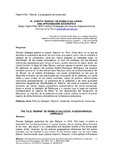| dc.rights.license | http://creativecommons.org/licenses/by-nc-sa/3.0/ve/ | |
| dc.contributor.author | Foghin Pillin, Sergio | |
| dc.date.accessioned | 2015-07-22T17:26:22Z | |
| dc.date.available | 2015-07-22T17:26:22Z | |
| dc.date.issued | 2015-01 | |
| dc.identifier.issn | 2244-7008 | |
| dc.identifier.uri | http://www.saber.ula.ve/handle/123456789/40713 | |
| dc.description.abstract | Rómulo Gallegos publicó el cuento “Marina” en 1919. Dicha obra, en la que se describe la angustiosa situación de una mujer muy pobre, quien vela en soledad el cadáver de su compañero, tiene por marco espacial un desolado lugar, no identificado, de las costas venezolanas, el cual, sin embargo, por las precisas referencias geográficas que incluyó el autor, puede ubicarse en algún sector del Litoral Central, no lejos de Cabo Blanco, como lo supuso el escritor Juan Liscano. No obstante, en opinión del profesor Adolfo Rodríguez Rodríguez, los sucesos narrados ocurren en el sitio denominado Maurica, cerca de la desembocadura del río Neverí, en el estado Anzoátegui. Las duras condiciones en las que se desarrolla el drama, se ven acentuadas por la irrupción de la caldereta, un viento cálido y seco, propio de las costas centrales, capaz de producir determinadas reacciones psicosomáticas. La presencia de la caldereta y de otros puntuales elementos topográficos, identificables en “Marina”, así como la ausencia en esta narración de ciertos rasgos geográficos característicos del litoral barcelonés, llevan a refutar la hipótesis de Rodríguez y a concluir que el lugar en cuestión correspondería al caserío de Mare, en las adyacencias del aeropuerto de Maiquetía. La mención de la caldereta en este cuento, podría constituir el primer registro de dicho fenómeno atmosférico en la literatura venezolana. | es_VE |
| dc.language.iso | es | es_VE |
| dc.rights | info:eu-repo/semantics/openAccess | |
| dc.subject | Rómulo Gallegos | es_VE |
| dc.subject | “Marina” | es_VE |
| dc.subject | Caldereta | es_VE |
| dc.subject | Geografía de Venezuela | es_VE |
| dc.title | El cuento “Marina” de Rómulo Gallegos: una aproximación geográfica | es_VE |
| dc.title.alternative | The tale “Marina” by Rómulo Gallegos: a geographical approach | es_VE |
| dc.type | info:eu-repo/semantics/article | |
| dc.description.abstract1 | Rómulo Gallegos published the tale “Marina” in 1919. This work, in which is described the harrowing situation of a poor woman, who is viewing alone the body of his man, take place in an unidentified and desolate hamlet of the Venezuelan
coasts, which, however, by the precise geographical references that the author included, can be located in any sector of the central coast, not far from Cabo Blanco, how the writer Juan Liscano meant it. However, in the opinion of Professor Adolfo Rodriguez Rodríguez, the narrated events occur in the site named Maurica, near the mouth of the Neverí River, in Anzoátegui State. The harsh environment, in which the drama is developed, is accentuated by the irruption of the caldereta, a warm and dry föhn-type wind, typical of the Venezuelan central coast, which is capable of producing certain psychosomatic reactions. The presence of the caldereta and other identifiable topographical elements in “Marina”, as well as the absence in this narration of certain geographical features of the Barcelona coast, leading to refute the hypothesis of Rodriguez and concluded that the site correspond to the hamlet of Mare, adjacent to the airport of Maiquetía. The
mention of the caldereta in this story, could be the first record of this atmospheric phenomenon in Venezuelan literature. | es_VE |
| dc.description.colacion | 33-46 | es_VE |
| dc.description.email | sfoghin@hotmail.com | es_VE |
| dc.description.frecuencia | Semestral | |
| dc.identifier.depositolegal | PPI200302ME3529 | |
| dc.publisher.pais | Venezuela | es_VE |
| dc.subject.institucion | Universidad de Los Andes | es_VE |
| dc.subject.keywords | Rómulo Gallegos | es_VE |
| dc.subject.keywords | “Marina” | es_VE |
| dc.subject.keywords | Caldereta | es_VE |
| dc.subject.keywords | Venezuelan geography | es_VE |
| dc.subject.publicacionelectronica | Revista Bitácora-e | |
| dc.subject.seccion | Revista Bitácora-e: Artículos | es_VE |
| dc.subject.thematiccategory | Artes y Humanidades | es_VE |
| dc.subject.tipo | Revistas | es_VE |
| dc.subject.unidadinv | Grupo Venezolano de Historia y Sociología de la Ciencia (GVHSC) | es_VE |
| dc.type.media | Texto | es_VE |


